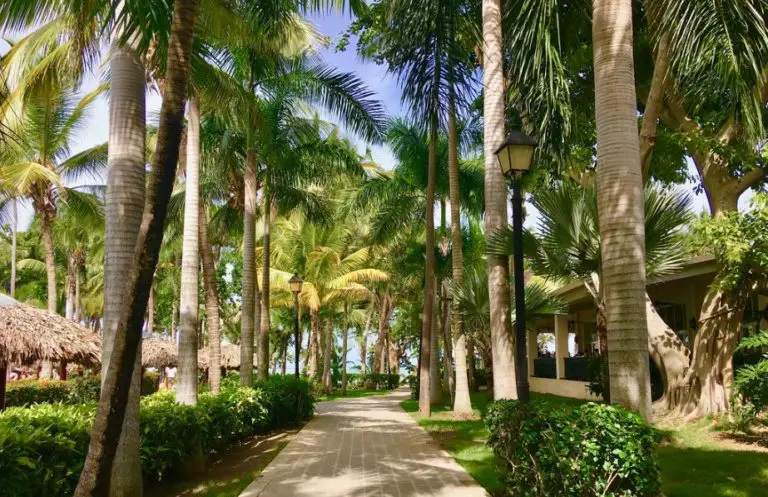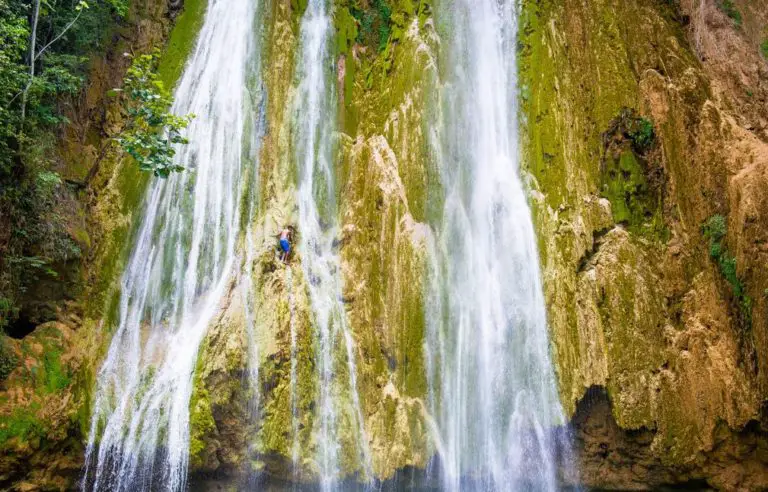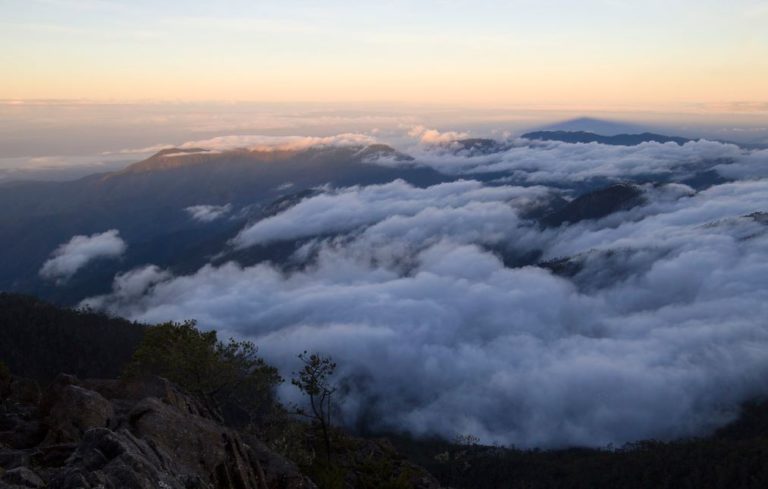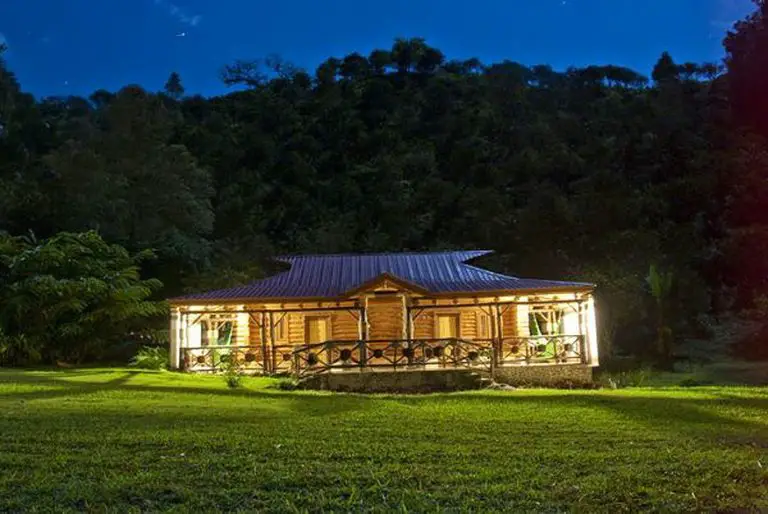20 Beautiful Places And Things To Do In The Dominican Republic

From beautiful and paradisiacal beaches, natural landscapes, to buildings with a deep historical meaning and romantic places, the Dominican Republic is a country with a lot of diversity, privileged by God, time and nature with landscapes and places of a unique beauty that are worth knowing.
There are a lot of landscapes and popular tourist places, some much more popular than others but they all maintain their charm and uniqueness, in this theme I will show you some of the most popular and well-known places in the country as tourist destinations.
This topic will not cover much the best beaches since I am working on another topic with more complete information on the best beaches in the country.
Contents
1-Colonial City of Santo Domingo

Known as “the first city of the new world”, founded in 1502 by Spanish colonizers, this is definitely my favorite place in Santo Domingo because of the romanticism that is felt and the architecture that can be seen in the buildings, the colonial city is one of the primary destinations to know in the Dominican Republic, its streets and buildings are historic, its atmosphere is full of emotions and romanticism. The architecture of the colonial city is Exquisite, it is a mixture of different European architectural styles, for its historical legacy the colonial city was declared a World Heritage Site by the unit nations.
I love the bohemian and romantic atmosphere of the colonial city of Santo Domingo, it’s like having a piece of history frozen in time, trapped in each wall of the buildings, the colonial city is a living witness of the formation of a new era.
If you want to know more about the colonial city I wrote a topic about it, click here…
2-Bavaro Beach

Bávaro beach is located on the north coast of Punta Cana, in the southwest of the Dominican Republic, it is a 3 km long beach. It is a white sand beach, very extensive, lined with coconut trees, it opens over the Atlantic Ocean.
The beach is protected by a coral reef, its waters are maintained at a temperature of 28 ° C and a beautiful turquoise color. It is a beautiful and colorful landscape, nuanced by the orange of the sun’s rays, the white foam of the waves that integrates with the white sands, the contrasting green of the palm trees and the deep turquoise blue of the beach waters.
The area of Bavaro is very touristy due to its climate and beautiful beach, there are a variety of all-inclusive hotels aligned along the beach, prepared to receive tourists of different nationalities.
3-Casa de Campo

It is a luxurious Caribbean tourist destination located in La Romana, southeast coast of the Dominican Republic, considered one of the best tourist centers of the Caribbean, has a variety of structures and activities aimed at leisure and rest, has villas facing the Sea, equestrian spa center, marina, world-class golf, shooting center and other services, Casa de Campo also has several golf courses by Pete Dye, some of them affected as the most difficult of the game.
Casa de Campo is also home to Altos de Chavón, an artisan villa inspired by a 16th-century Mediterranean city with a cultural center, boutiques, museums and a 5,000-seat Greek-style amphitheater inaugurated by Frank Sinatra in August 1982, where occasionally performs important concerts.
4-Los Haitises National Park

Los Haitises National Park, in the northeast of the Dominican Republic, is one of the richest mangrove reserves in the world, comprising a variety of wildlife, vegetation, and a beautiful virgin landscape, by national law, the park belongs to the system of protected areas of the country, for its importance as a tropical ecosystem.
A diversity of attractive landscape elements can be found in Los Haitises National Park, as they are; the different keys, the San Lorenzo Bay and the mangrove populations. Los Haitises is an important part of the Caribbean tropical ecosystem, it is a habitat of various species of migratory and native birds; it has a large mangrove area and a complex system of caves where pictographs and petroglyphs of great historical and archaeological value are found.
5-The Bani Dunes

Located on the “Las Calderas Peninsula”, the Bani Dunes correspond to one of the best places for nature lovers with great tourist value in the Dominican Republic, a magnificent setting made up of an immense sand desert, with huge dunes that reach 35 meters high and extending for about 3 kilometers wide and 15 kilometers long.
The native vegetation of the place, made up of endemic species such as olives and cambron, complements the landscape, next to the calm waters of the Bay of Las Calderas, adorning the horizon. A short distance from the Bani Dunes, there is Punta Salinas beach, an ideal beach for windsurfing and kitesurfing and for cooling off.
6-Samana Peninsula

With approximately 60 kilometers long and 19 wide, This peninsula in the northeast corner of the country brings together some of the most beautiful beaches and ecotourism destinations in the Dominican Republic, its landscapes are characterized by its green mountains and subtropical humid forests.
Among its various tourist sites, including the beautiful beaches of Las Terrenas, Rincon and Cayo Levantado and the Cascada del Limón with its 30-meter waterfall. Between January and March, you can admire the exhibition of humpback whales that connect to the Bay of Samaná to reproduce.
7-San Felipe de Puerto Plata

On the shores of the Atlantic Ocean, it is recognized as one of the most beautiful cities in the country, this city is a combination of beautiful beaches, history, and modernity, there are a variety of services and tourist places, among which there are many hotels, restaurants, a lively nightlife, and shopping centers.
Among its various tourist attractions, its cable car stands out, on an 800-meter route, ascends to Christ the Redeemer on Isabel de Torres Mountain, showing a view of a beautiful landscape in its route, forming the typical postcard of the city. Other attractions are its historic Victorian center, its promenade that ends in the old Fortress of San Felipe and beautiful beaches such as Playa Dorada.
My dad worked in Puerto Plata many years ago, specifically in Playa Dorada, I remember that he had surfboards for rent, sold pineapple drinks on the beach, did different jobs in the tourism sector, I remember visiting the city as a child, the beautiful beach and very warm and friendly people.
8-Los 27 Charcos de Damajagua

This beautiful place is located just 10 kilometers from the city of San Felipe de Puerto Plata, It is a popular tourist destination, corresponds to a set of 27 waterfalls of various sizes, whose origin is born from the Damajagua River, in its passage natural pools and springs are formed in the middle of the forest.
Another of its attractions is the landscape that surrounds this natural wonder, with mountainous areas and virgin forest areas that make home to varied native wildlife and vegetation. The excursions to the place usually establish an ascent route through walks and descent through natural slides, sliding between the puddles.
9-Bayahibe

Bayahibe is a city on the shores of the Caribbean Sea, it is an old fishing village whose main activity is tourism for its tourist attractions formed by its beautiful white-sand beaches and turquoise waters and its privileged geographical location as a door Entrance to the National Park of the East. Bayahibe is one of the best tourist places in the Dominican Republic for diving enthusiasts, it has seabed that stands out for its biodiversity and transparency.
Bayahibe has several places of interest in its surroundings, such as Isla Saona, Catalina Island, or the picturesque village Altos de Chavón, the latter built in 1976, alluding to a medieval Italian city.
10-The Saona Island

Saona Island is within the Cotubanamá National Park, off the coast of Bayahibe, recognized for its beautiful beaches where white sands, turquoise waters and coral reefs are found. The most popular among them is Canto de Agua, Saona Island is one of the largest in the Dominican Republic, within it are several human settlements including a fishing village.
Isla Saona has several caves of the Taíno culture and archaeological sites. A few meters from the coast, the so-called natural pool is one of its most popular attractions, where it is possible to dive into sea beds that stand out for their biodiversity and transparency, with various species such as the starfish.
11-Bahia de las Aguilas

In the Jaragua National Park, it is recognized for its kilometers of pristine beaches with transparent waters and white sands, surrounded by gigantic rocks, considered among the most crystalline beaches on the planet. Its seabed houses extraordinary biodiversity of species, and impressive coral reefs, ranked among the best preserved in the Caribbean.
The surroundings of the bay comprise the arid landscapes of the park where many caverns preserve pictographs and petroglyphs of pre-Hispanic cultures.
12-Cascada del salto del limon, Samana

The Lemon Waterfall is an attractive tourist site integrated to the Samaná Tourist Cluster on the north coast of the Dominican Republic, it is an excellent place to do ecotourism and hiking, integrated in a tropical forest with abundant vegetation and wildlife, the waterfall of the Lemon Leap It measures approximately 50 meters high and has a natural pool.
The route to the waterfall can be done on foot or horseback, they also offer guided tour services, although not expendable, on the walking tour you can discover several waterfalls of different sizes, it is necessary to have a shoe suitable for walking on the ground rugged and wet stones, carrying a cane or stick for support during the walk is also a good idea.
13-Laguna el Dudú, Nagua-Cabrera

This beautiful place is on the north coast of the Dominican Republic, it is a lagoon in the middle of a lush forest, The Dudú comprises two lagoons, the main lagoon surrounded by gorges, from where it can be launched by the zipline which runs through the lagoon almost end to end to experience an adrenaline-laden adventure. The other lagoon known as the “Pozo del Caballo” is a shallow water resort where the crystalline turquoise of its waters invites you to take a refreshing swim while admiring a majestic and paradisiacal nature.
Actually, El Dudú has the distinction of being the only place in the world where you can practice speleobuceo from a natural lake to another natural lake, this makes it a peculiar and special place for diving enthusiasts, this sport comprises diving into underground caves full of water, which come from different parts of the world, the caving route lasts about 45 minutes.
14-Salto Jimenoa

Located in the municipality of Jarabacoa, it is a waterfall surrounded by a beautiful natural landscape. There are several routes to get to Jimenoa Falls, you can usually walk through mountains and plains that surround the river that feeds on the great waterfalls.
It is necessary to cross a suspension bridge to access the jump; the bridge is about 100 meters long and is on the Jimenoa River, you can see lush vegetation. Other ways to get to the jump are on horseback or in a 4×4 vehicle until you reach the suspension bridge since the bridge can only be crossed on foot.
15-Whale Watching, Samana

Visiting the Humpback Whale Sanctuary in Samaná Bay is an unforgettable experience, to observe these gigantic aquatic mammals that come to mate and reproduce.
Between January and March of each year, approximately 3,000 Humpback whales visit the warm waters on the shores of the Atlantic Ocean to reproduce. It is an impressive spectacle, in the Samaná Bay every summer the humpback whales that come from the seas of Greenland, Iceland, North America, and Canada, reach the warm waters of the Caribbean Sea to find a mate and give birth, thousands of whales stay in Bahia Samana.
When the 40-ton males jump over the water and fall a few meters ahead to get the attention of the female and if it does not react to this act, the male will try to attract them with a monotonous and long song and the whales can hear this song until a radius of 30 kilometers. You can listen to this song only submerged. The whales prepare their return to the North after giving birth to their young.
16-Cayo Levantado, Samana

Cayo Levantado, is a small and beautiful island located in the northeast of the Dominican Republic in the bay of Samaná, it has beautiful white sand beaches, crystal clear waters, and humid forest vegetation, distinguishable and that together form a beautiful landscape.
Cayo Levantado is a good place from where you can see humpback whales, who visit the place from January to March to mate and reproduce. An ideal place to enjoy nature and relax. You can walk the entire island on foot in only 15 minutes.
Cayo Levantado has an approximate extension of 1 kilometer, in spite of its small size it is possible to spend a pleasant holiday in this place, the Hotel Gran Bahía Príncipe is located inside the island.
17-Montaña Redonda, Miches

Round Mountain, It is in Miches in the province’s Municipality of El Seibo, between Rincón Lagoon and Redonda Lagoon, it has a beautiful natural landscape; it is approximately 1,000 feet high; the mountain has a 360 degree view from which it allows contemplate some places of the environment such as Redonda lagoon, Samana Bay, Limón, Miches, and Seibo.
The beautiful and unique nature of the mountain is representative of its swings, which allow you to feel the sensation of flying in nature, you can also camp in this place and witness different climates at the same time: you could see rains on one side and the radiant sun on the other side from the distance.
18-Green ebony scientific reserve

The Green Ebony Scientific Reserve is in the province of La Vega, covers an area of 36 km and its highest elevation is the “Loma de las Golondrinas” with 1,565 meters above sea level, the name of “scientific reserve” is because of its Outstanding ecosystem, with a great variety of landscapes, vegetation and wildlife of great national scientific relevance.
This reserve is one area with the most endemic plants in the Dominican Republic and protects green ebony. 687 species of vascular plants have been reported, of which 153 are endemic to the country.
The reserve is born some very important rivers such as the Jatubey river that discharges its waters in the Rincón dam and the Camú river that runs 12 km from its source to the limit of the reserve.
The Green Ebony scientific reserve is usually visited by hikers who love ecotourism, you need a permit to travel one trail of the reserve, the most popular can be traveled between 3 and 4 hours walking and is 5 km away.
19-Pyramids of Valle Nuevo, Valle Nuevo

On the old municipal border between Constanza and San José de Ocoa, next to the road, in the area known as “The fridge”, due to the cold environment, the pyramid comprises four segments, this structure is part of the New Valley Reserve located a height of 2,300 meters above sea level, a place where the temperature can drop to 0 degrees Celsius in winter.
Access to the area of the pyramids has an average cost of US $2, this is paid at the booth where visitors are received. From the town of Constanza to the Pyramids of Valle Nuevo, the route takes approximately 1 hour and 45 minutes at a moderate speed.
You can camp in this beautiful place, but you must be prepared for the cold of the night and the morning, it is recommended to be careful on the route from Constance to the entrance of the park, for the narrow path, the curves, and the others vehicles that go down. It is important to take into consideration to visit the pyramids, go by double-traction vehicle, because of road conditions.
20-Pico Duarte

It is a mountainous system in the Dominican Republic, between the National Parks of José Armando Bermúdez and the José del Carmen Ramirez National Park, it is the highest mountain range in the Antilles and where the two most important rivers in the country are born.There are 5 established routes to climb the Pico Duarte to the top, the route that begins in Jarabacoa is the most popular.
The excursion is required to hire official local guides; it is not allowed to climb without these; it is also necessary to get a permit to enter the National Park. Usually, he will require the use of mules to climb, to carry the load.
The routes can be started and finished wherever they plan flexibly, but a trip that starts and ends in different places is more expensive since local and mule guides who hire the tour have to return to the place of departure, adding several more days of cost for that group.
A common route using mixed routes is to start in Mata Grande and finish at La Ciénaga. Regularly trips are between December and March as it is the least rainy season, therefore there are minor fire risks, and it is also outside the cyclonic season.







